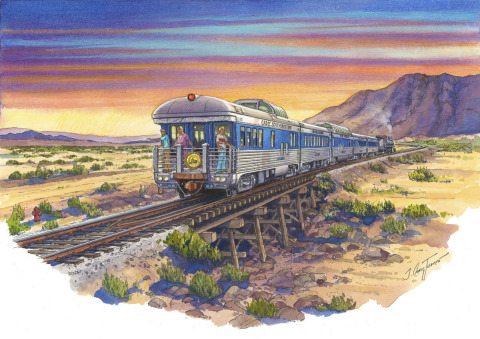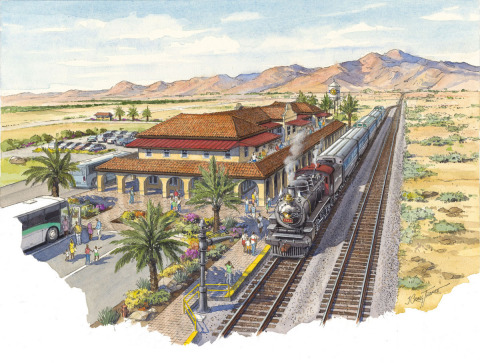CADIZ, Calif.--(BUSINESS WIRE)--Today Cadiz Inc. [NASDAQ:CDZI] (“Cadiz”, the “Company”) is pleased to announce that it has entered into a new trackage rights agreement (“Agreement”) with the Arizona & California Railroad Company (“ARZC”) that will facilitate the development of regularly scheduled steam train excursions through the celebrated Mojave Desert between Cadiz, California and Parker, Arizona, which would be one of the longest steam train excursion routes in the United States. The proposed new steam train operation, named the Cadiz Southeastern Railway (“CSER”), will be powered by water made available from the Cadiz Valley Water Conservation, Recovery & Storage Project (“Cadiz Water Project”) and, following the completion of additional permitting, will also feature a new museum and cultural center at the Cadiz Ranch property dedicated to the promotion of local desert and railroad history.
“The steam train is an original fixture of the Cadiz area - an important historical asset intimately connected to the local culture – and offers a rewarding way to invest locally and promote the unique desert environment,” said Scott Slater, Cadiz President. “As a 30-year member of the Mojave Desert community, we have long appreciated the area’s majesty and appeal and are proud to diversify our business with this exciting new venture.”
The CSER will operate on existing tracks along an 85-mile portion of the ARZC between Parker, Arizona and Cadiz, California with water stops in desert locales of Milligan, Chubbuck, Rice and Vidal. This Mojave Desert Route, which is located just off historic Route-66, provides sweeping views of the vast desert wilderness, mountainous terrain and the Colorado River.
“The CSER route is nestled between the bustling desert tourist areas of Joshua Tree National Park, Mojave National Preserve, the Colorado River, Lake Havasu and Phoenix, Arizona,” noted Rob Mangels, a veteran of the steam locomotive industry and Senior Manager of the Cadiz Southeastern Railway operation. “As one of the longest, scheduled steam train operations in the U.S., the CSER will create a new magnet for tourists and railfans alike, adding new dollars to the desert tourist economy.”
CSER rail adventures will provide a new way for the public to visit the Mojave Desert in a safe and comfortable setting not available from local highways or roads. The operation will be an entertainment-based attraction offering both traditional excursion and themed rail rides. The museum and cultural center planned for Cadiz will serve as the operation’s educational hub. Visitors to the center, who arrive via rail or vehicles traveling along Route-66, will learn about the historical development of the area and the region’s connection to the railroad industry.
Cadiz, California was developed in 1883 as a small rail siding for transcontinental railroads heading west. According to historical accounts, Cadiz became a key watering stop for steam locomotives during the West’s expansion as railroad traffic to Los Angeles continued to increase. The ARZC route became operational in 1910 serving as shortcut for freight and passengers moving between Los Angeles and Phoenix as well as serving towns and communities along the line. Steam-powered locomotives relied on water at Cadiz until the mid-1950s, when the railroads shifted to diesel-electric locomotives.
The CSER operation will employ historic steam locomotives and vintage passenger railcars that will be modernized to incorporate current environmental and mechanical technologies. As CSER prepares its facilities and equipment, it intends to work with the San Bernardino Railroad Historical Society, which maintains a 1927-built steam locomotive, Atchison, Topeka and Santa Fe number 3751, to operate limited runs of the 3751 on the route.
Paul Prine, President of the San Bernardino Railroad Historical Society, noted that “more frequent operation of steam locomotives in this economically depressed region would create a definite positive benefit, and this could not occur without the reliable source of good water made available by the Cadiz Project. We look forward to participating in this operation with the 3751 and see people turn out all along the line to take in the steam experience.”
Under the terms of the Agreement, CSER will operate and maintain its own steam locomotives, passenger cars and terminals within ARZC property. The CSER operation will augment current traffic on the ARZC without interfering with existing freight operations.
“This latest agreement with Cadiz continues to further ARZC’s objectives in the region. Along with fire suppression capabilities, road access and power previously secured by ARZC from the Cadiz Water Project, the water pipeline in the ARZC right-of-way now has the potential to contribute additional revenue through increased railroad traffic,” said Brad Ovitt, President of the ARZC.
The construction and operation of the CSER and the museum and cultural center will be subject to implementation of the Cadiz Water Project as well as additional local permitting and environmental review.
About Cadiz
Founded in 1983, Cadiz Inc. is a publicly-held renewable resources company that owns 70 square miles of property with significant water resources in Southern California. The Company is engaged in a combination of organic farming and water supply and storage projects at its properties and abides by a wide-ranging “Green Compact” focused on environmental conservation and sustainable practices to manage its land, water and agricultural resources. For more information about Cadiz, visit http://www.cadizinc.com/.
FORWARD LOOKING STATEMENT: This release contains forward-looking statements that are subject to significant risks and uncertainties, including statements related to the future operating and financial performance of the Company and the financing activities of the Company. Although the Company believes that the expectations reflected in our forward-looking statements are reasonable, it can give no assurance that such expectations will prove to be correct. Factors that could cause actual results or events to differ materially from those reflected in the Company’s forward-looking statements include the Company’s ability to maximize value for Cadiz land and water resources, the Company’s ability to obtain new financing as needed, the receipt of additional permits for the water project and other factors and considerations detailed in the Company’s Securities and Exchange Commission filings.





